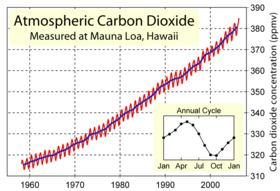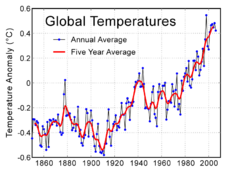Global Warming
From Lauraibm
Contents |
Articles in the Press
MI Summary
Global Warming
Global warming is the increase in the average temperature of the Earth’s near-surface air and oceans in recent decades and its projected continuation. It is thought that most of the observed increase in globally averaged temperatures since the mid 20th century is likely to be due to the increase in anthropogenic greenhouse gas concentrations. Most national governments have now signed and ratified the Kyoto Protocol, aimed at combating greenhouse gas emissions.
It is hard to give detail of causes of recent warming as this is an area under research; however, the scientific consensus identifies increased levels of greenhouse gases due to human activity as the main influence.
The greenhouse effect is the process by which absorption and emission of infrared radiation by atmospheric gases warms a planet’s atmosphere and surface, without the greenhouse effect the mean temperature of the earth would be an estimated 30 degrees C lower, hence the earth would be uninhabitable. On Earth the major natural greenhouse gases are water vapour, carbon dioxide, methane and ozone. It is expected that within the future CO2 levels will rise due to the ongoing burning of fossil fuels and land use change.
It is thought that variations in solar output, possibly amplified by cloud feedbacks, may have contributed to recent warming.
Text of Article
Global warming refers to the increase in the average temperature of the Earth's near-surface air and oceans in recent decades and its projected continuation.
Global average air temperature near the Earth's surface rose 0.74 ± 0.18 °C (1.33 ± 0.32 °F) during the past century. The Intergovernmental Panel on Climate Change (IPCC) concludes, "most of the observed increase in globally averaged temperatures since the mid-20th century is very likely due to the observed increase in anthropogenic greenhouse gas concentrations," which leads to warming of the surface and lower atmosphere by increasing the greenhouse effect. Natural phenomena such as solar variation combined with volcanoes have probably had a small warming effect from pre-industrial times to 1950, but a small cooling effect since 1950. These basic conclusions have been endorsed by at least 30 scientific societies and academies of science, including all of the national academies of science of the major industrialized countries. The American Association of Petroleum Geologists is the only scientific society that rejects these conclusions. A few individual scientists disagree with some of the main conclusions of the IPCC.
Climate models referenced by the IPCC project that global surface temperatures are likely to increase by 1.1 to 6.4 °C (2.0 to 11.5 °F) between 1990 and 2100. The range of values reflects the use of differing scenarios of future greenhouse gas emissions and results of models with differences in climate sensitivity. Although most studies focus on the period up to 2100, warming and sea level rise are expected to continue for more than a millennium even if greenhouse gas levels are stabilized. This reflects the large heat capacity of the oceans.
Remaining scientific uncertainties include the exact degree of climate change expected in the future, and how changes will vary from region to region around the globe. There is ongoing political and public debate on a world scale regarding what, if any, action should be taken to reduce or reverse future warming or to adapt to its expected consequences. Most national governments have signed and ratified the Kyoto Protocol, aimed at combating greenhouse gas emissions.
Causes
The climate system varies through natural, internal processes and in response to variations in external forcing factors including solar activity, volcanic emissions, variations in the earth's orbit (orbital forcing) and greenhouse gases. The detailed causes of the recent warming remain an active field of research, but the scientific consensus identifies increased levels of greenhouse gases due to human activity as the main influence. This attribution is clearest for the most recent 50 years, for which the most detailed data are available. Contrasting with the scientific consensus, other hypotheses have been proposed to explain most of the observed increase in global temperatures. One such hypothesis is that the warming is caused by natural fluctuations in the climate or that warming is mainly a result of variations in solar radiation.
None of the effects of forcing are instantaneous. Due to the thermal inertia of the Earth's oceans and slow responses of other indirect effects, the Earth's current climate is not in equilibrium with the forcing imposed. Climate commitment studies indicate that even if greenhouse gases were stabilized at present day levels, a further warming of about 0.5 °C (0.9 °F) would still occur.
Greenhouse gases in the atmosphere
The greenhouse effect was discovered by Joseph Fourier in 1824 and was first investigated quantitatively by Svante Arrhenius in 1896. It is the process by which absorption and emission of infrared radiation by atmospheric gases warms a planet's atmosphere and surface.
Greenhouse gases create a natural greenhouse effect, without which mean temperatures on Earth would be an estimated 30 °C (54 °F) lower so that Earth would be uninhabitable. Thus scientists do not "believe in" or "oppose" the greenhouse effect as such; rather, the debate concerns the net effect of the addition of greenhouse gases, while allowing for associated positive and negative feedback mechanisms.
On Earth, the major natural greenhouse gases are water vapor, which causes about 36–70% of the greenhouse effect (not including clouds); carbon dioxide (CO2), which causes 9–26%; methane (CH4), which causes 4–9%; and ozone, which causes 3–7%. Some other naturally occurring gases contribute very small fractions of the greenhouse effect; one of these, nitrous oxide (N2O), is increasing in concentration owing to human activity such as agriculture. The atmospheric concentrations of CO2 and CH4 have increased by 31% and 149% respectively above pre-industrial levels since 1750. These levels are considerably higher than at any time during the last 650,000 years, the period for which reliable data has been extracted from ice cores. From less direct geological evidence it is believed that CO2 values this high were last attained 20 million years ago. "About three-quarters of the anthropogenic [man-made] emissions of CO2 to the atmosphere during the past 20 years are due to fossil fuel burning. The rest of the anthropogenic emissions are predominantly due to land-use change, especially deforestation."

The present atmospheric concentration of CO2 is about 383 parts per million (ppm) by volume. Future CO2 levels are expected to rise due to ongoing burning of fossil fuels and land-use change. The rate of rise will depend on uncertain economic, sociological, technological, natural developments, but may be ultimately limited by the availability of fossil fuels. The IPCC Special Report on Emissions Scenarios gives a wide range of future CO2 scenarios, ranging from 541 to 970 ppm by the year 2100. Fossil fuel reserves are sufficient to reach this level and continue emissions past 2100, if coal, tar sands or methane clathrates are extensively used.
Positive (reinforce) feedback effects such as the expected release of CH4 from the melting of permafrost peat bogs in Siberia (possibly up to 70,000 million tonnes) may lead to significant additional sources of greenhouse gas emissions not included in climate models cited by the IPCC.
Transportation fuels account for a third of US greenhouse pollution.
Solar Variation
Variations in solar output, possibly amplified by cloud feedbacks, may have contributed to recent warming. A difference between this mechanism and greenhouse warming is that an increase in solar activity should produce a warming of the stratosphere while greenhouse warming should produce a cooling of the stratosphere. Reduction of stratospheric ozone also has a cooling influence but substantial ozone depletion did not occur until the late 1970s. Cooling in the lower stratosphere has been observed since at least 1960. Thus, solar activity alone is not the main contributor to recent warming.
Phenomena such as solar variation combined with volcanoes have probably had a warming effect from pre-industrial times to 1950, but a cooling effect since 1950. However, some research has suggested that the Sun's contribution may have been underestimated. Two researchers at Duke University have estimated that the Sun may have contributed about 40–50% of the global surface temperature warming over the period 1900–2000, and about 25–35% between 1980 and 2000. Stott and coauthors suggest that climate models overestimate the relative effect of greenhouse gases compared to solar forcing; they also suggest that the cooling effects of volcanic dust and sulfate aerosols have been underestimated. Nevertheless, they conclude that even with an enhanced climate sensitivity to solar forcing, most of the warming during the latest decades is attributable to the increases in greenhouse gases.
More studies on the extent of warming caused by changes in the brightness of the sun have been conducted. Scientists from the United States, Germany, and Switzerland under Heliophysics, Inc. and the National Science Foundation calculated that there has been no net increase of brightness over the last thousand years. All increases in brightness were the result of solar cycles, and the small increase in brightness over the last 30 years is .07 percent. Scientists say that this small increase is far too minute to contribute to global warming.



